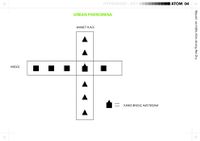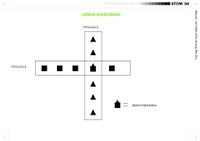atom04:'''identity concept'''
| Line 36: | Line 36: | ||
[[File:atom4_urbanphenomena3.jpg|200px]] | [[File:atom4_urbanphenomena3.jpg|200px]] | ||
| − | |||
| − | |||
| − | |||
| − | |||
| − | |||
| − | |||
| − | |||
| − | |||
| − | |||
| − | |||
| − | |||
| − | |||
| − | |||
| − | |||
| − | |||
| − | |||
| − | |||
| − | |||
| − | |||
| − | |||
| − | |||
| − | |||
| − | |||
| − | |||
| − | |||
| − | |||
| − | |||
Latest revision as of 15:18, 17 October 2011
Contents |
IDENTITY
DIFFERENTIATION
The state or relation of being different, dissimilarity. A significant change in or effect on a situation, distinctive quality, feature.
Henri-Louis Bergson distinguses difference in kind and difference in degree. Deleuze argues that difference should fundamentally be the object of affirmation and not negation. Difference in kind is related to continuous multiplicity discrete multiplicities. Its main characteristics are virtual difference, qualitative discrimination, subjetive relation and the connection to the time (duration).
Difference itself is a characteristic that gives a value to the event.
PERSONALIZATION
- the achieving of individual, relating to, directed to, or intended for a particular person. usually involving personal remarks as character, behavior, appearance, interests, social category, context. It also involves the idea of customization, the using of the technology to accommodate the differences between individuals.
Personal continuity, a time concept, is an important part of identity. personal experiences are connected to the qualities such as self-awareness, sentience, sapience, but also to the ability to perceive the relationship between oneself and one's environment. Personal continuity is the property of a continuous and connected period of time and is intimately concerned with a person's body or physical being. Through contiguity, one associates ideas or events that usually happen to occur at the same time. The personal continuity is the keyword behind the habit and the routine.
The concept of personal is related to the concept of time through routines, habits and the memory. The reactions are based on personal intuitions and feelings. Surprising and strong events can be caught through personalized, specific experience.
URBAN PHENOMENA
a spatial setting that is creating a cultural relevance. Urban phenomena can be seen as differing spatial quality, emotionally loaded. Its cultural importance overweighs its logistical and contextual situation. Not a difference in degree, but difference in kind.
Most well known urban phenomena is the Bilbao effect. In Bilbao's urban regeneration plan, Frank Gehry's Guggenheim museum managed to change the identity of the city itself - the rundown area of a city in economic decline was brought to huge financial growth and prestige, the Bilbao changed from problematic industrial town to a global tourist destination. The effect was achieved through one extraordinary building, the Bilbao's Guggenheim Museum. Due to the scale and the budget Gehry's building became the symbol of its Kind, the beginning of iconic objects. It was already loaded with the emotions created by Deconstructivist movement in architecture, it wasn't a manifesto building any more, but big a cultural temple, a delivery project of the new spatial qualities.
Urban phenomenas can be found in different scale. Bilbao effect is clearly a global one. In smaller scale, locally, the scheme also works. Local urban phenomenas work according to similar pattern. They are connected to an attempt to produce a "delight rating" for a given space. The space has to be designed as an easily memorisable one, but also different from the already seen and sensed. Urban Phenomenas need strong, surprising, routine breaking experiences.

